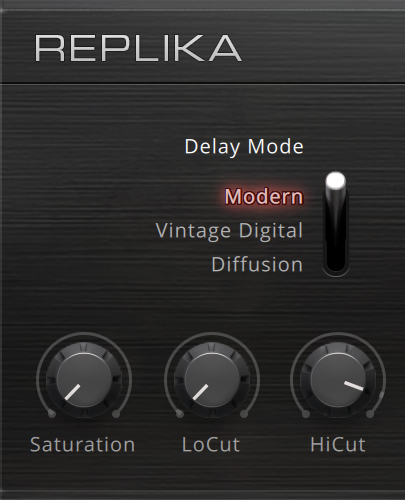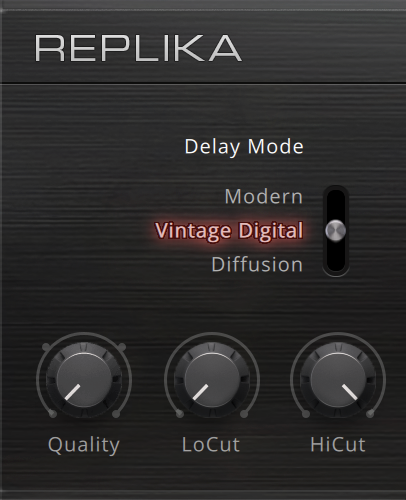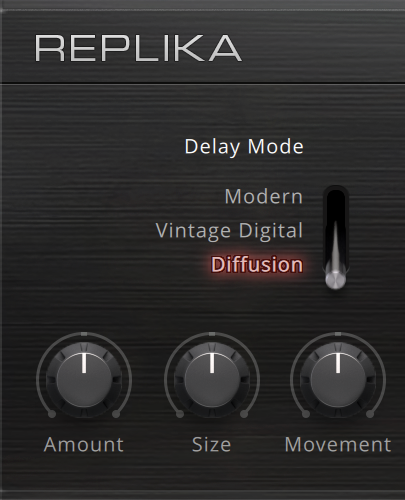Style Section
REPLIKA offers three distinct delay styles, each with their own unique sound and behavior. Each style has a set of parameters that enable you to adjust the character of the delay.
REPLIKA offers three distinct delay styles, each with their own unique sound and behavior. They all share the same settings in the Delay section, so you can switch between styles while keeping all your basic delay parameters intact. Each style has a set of additional parameters that enables you to further adjust the character of the delay.
The following styles are available:
Modern: Clean and defined delay with adjustable, tube-like saturation. It has a delay time range of 1-2000 ms, or 1/64 to 2/1 in synchronized Time modes. For more information, refer to Modern.
Vintage Digital: Warm and crunchy emulation of early digital delay effects. It has a delay time range of 20-2000 ms, or 1/64 to 2/1 in synchronized Time modes. For more information, refer to Vintage Digital.
Diffusion: Clean delay combined with a unique reverb effect. It has a delay time range of 1-2000 ms, or 1/64 to 2/1 in synchronized Time modes.For more information, refer to Diffusion.
Modern
The Modern style is a clean and defined delay that can be further shaped with its adjustable, tube-like Saturation. Manual adjustments of the delay time do not alter the pitch of the delay signal.
 |
Saturation: Adds tube-like saturation at the delay input. Turned all the way to the left, the knob bypasses saturation, turning it to the right pushes the sound from subtle warmth to overdrive. The amount of saturation is dependent on the input level.
Low Cut: Attenuates low-frequency content in the feedback path of the delay using a low-cut filter. Turned all the way to the left, the filter is off. Turning it to the right raises the cutoff frequency of the filter, resulting in a brighter tone of the delay.
Hi Cut: Attenuates high-frequency content in the feedback path of the delay using a high-cut filter. Turned all the way to the right, the filter is off. Turning it to the left lowers the cutoff frequency of the filter, resulting in a darker tone of the delay.
Vintage Digital
The Vintage Digital style emulates the warm and crunchy sound of early digital delay effects. Four different Quality settings available, ranging from a bright sound with subtle textures to strong digital artifacts. The sound of the delay depends on the delay time. As the delay time is increased, the delay repeats will become grittier, with more digital artifacts being introduced to the signal. Adjusting the delay time alters the pitch of the delay signal, which can be used creatively.
Tip
Try doubling the delay time, for example from 1/4 to 1/2. This shifts the delay signal one octave down. In the same way, halving the delay time shifts the delay signal one octave up.
 |
Quality: Selects one of four quality settings for the delay: High, Medium, Low, Crunch. The High setting has a bright, subtly textured sound. Medium and Low sound darker and grittier. Crunch has a bright sound but also introduces a lot of digital artifacts to the signal.
Low Cut: Attenuates low-frequency content in the feedback path of the delay using a low-cut filter. Turned all the way to the left, the filter is off. Turning it to the right raises the cutoff frequency of the filter, resulting in a brighter tone of the delay.
Hi Cut: Attenuates high-frequency content in the feedback path of the delay using a high-cut filter. Turned all the way to the right, the filter is off. Turning it to the left lowers the cutoff frequency of the filter, resulting in a darker tone of the delay.
Diffusion
The Diffusion Style links a clean delay to a unique reverb effect. It can be used to create a wide range of different ambiences, from tight and resonant to unnaturally vast spaces. The Amount of diffusion applied to the delay signal is freely adjustable, and the Movement control adds modulation to the reverb effect. Changing the delay time does not alter the pitch of the delay signal. However, adjusting the size of the reverb or increasing the amount of modulation can lead to pitch shifting sounds.
 |
Amount: Adjusts the amount of diffusion applied to the delay signal, resulting in a reverb effect. High settings make the delay appear out of sync, so low settings are recommended if the rhythmic timing of the delay is essential.
Size: Adjusts the swell, reflection pattern and decay of the reverb effect, giving the impression of differently sized spaces.
Movement: Adjusts the depth and speed of modulation applied to the diffusion, shifting the timing and pitch of the reflections for a wide reverb effect.